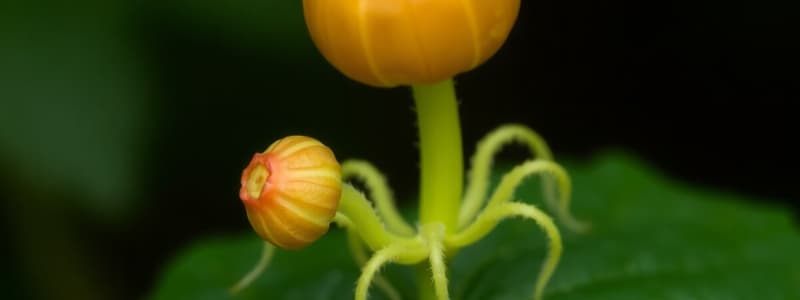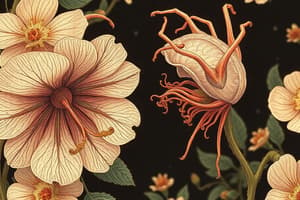Podcast
Questions and Answers
What is the process of formation of male and female gametes called?
What is the process of formation of male and female gametes called?
- Gametogenesis (correct)
- Meiosis
- Fertilisation
- Pollination
Which term describes organisms that possess both male and female reproductive organs?
Which term describes organisms that possess both male and female reproductive organs?
- Monoecious
- Hermaphrodites (correct)
- Dioecious
- Heterothallic
In which type of organisms are both gametes typically motile?
In which type of organisms are both gametes typically motile?
- Fungi and algae (correct)
- Gymnosperms
- Higher plants
- Animals
What term is used for the transfer of pollen grains from the anther to the stigma?
What term is used for the transfer of pollen grains from the anther to the stigma?
Which of the following statements is true about gametes?
Which of the following statements is true about gametes?
What type of plants typically require water for the motility of their gametes?
What type of plants typically require water for the motility of their gametes?
In diploid organisms, how do gamete mother cells form gametes?
In diploid organisms, how do gamete mother cells form gametes?
Which of these is true regarding isogametes?
Which of these is true regarding isogametes?
What is the main outcome of fertilization or syngamy?
What is the main outcome of fertilization or syngamy?
In which type of fertilization does syngamy occur outside the organism?
In which type of fertilization does syngamy occur outside the organism?
Which process involves the development of an embryo from the zygote?
Which process involves the development of an embryo from the zygote?
How do organisms with external fertilization typically produce gametes?
How do organisms with external fertilization typically produce gametes?
What occurs during parthenogenesis?
What occurs during parthenogenesis?
Which of the following is a characteristic of viviparous organisms?
Which of the following is a characteristic of viviparous organisms?
In organisms with haplontic life cycles, what does the zygote divide to form?
In organisms with haplontic life cycles, what does the zygote divide to form?
What happens to the sepals, petals, and stamens of a flower after fertilization?
What happens to the sepals, petals, and stamens of a flower after fertilization?
What is the primary characteristic of asexual reproduction?
What is the primary characteristic of asexual reproduction?
Which of the following is NOT a method of asexual reproduction?
Which of the following is NOT a method of asexual reproduction?
What term describes the lifespan of an organism?
What term describes the lifespan of an organism?
In which organisms does cell division serve as the mode of reproduction?
In which organisms does cell division serve as the mode of reproduction?
What type of reproductive structures might fungi use for reproduction?
What type of reproductive structures might fungi use for reproduction?
Which of the following is an example of vegetative reproduction?
Which of the following is an example of vegetative reproduction?
What is a potential ecological impact of water hyacinth?
What is a potential ecological impact of water hyacinth?
What do both asexual and sexual reproduction have in common?
What do both asexual and sexual reproduction have in common?
What is the juvenile phase in plants known as?
What is the juvenile phase in plants known as?
Which of the following best describes the outcome of sexual reproduction?
Which of the following best describes the outcome of sexual reproduction?
What hormone-related cycle occurs in female placental animals?
What hormone-related cycle occurs in female placental animals?
During which phase does the female permit copulation in the estrous cycle?
During which phase does the female permit copulation in the estrous cycle?
Which plant is known to flower once in its lifetime, typically after a long period?
Which plant is known to flower once in its lifetime, typically after a long period?
What happens to the broken endometrium during the estrous cycle?
What happens to the broken endometrium during the estrous cycle?
What significant transition occurs between different phases of the life cycle in both plants and animals?
What significant transition occurs between different phases of the life cycle in both plants and animals?
What marks the end of the reproductive phase in organisms?
What marks the end of the reproductive phase in organisms?
Flashcards
Reproduction
Reproduction
The process by which new organisms are produced from pre-existing ones.
Life Span
Life Span
The period from an organism's birth to its natural death.
Asexual Reproduction
Asexual Reproduction
Reproduction involving a single parent, without the fusion of gametes, creating offspring genetically identical to the parent.
Sexual Reproduction
Sexual Reproduction
Signup and view all the flashcards
Binary Fission
Binary Fission
Signup and view all the flashcards
Budding
Budding
Signup and view all the flashcards
Vegetative Propagules
Vegetative Propagules
Signup and view all the flashcards
Water Hyacinth
Water Hyacinth
Signup and view all the flashcards
Juvenile phase
Juvenile phase
Signup and view all the flashcards
Reproductive phase
Reproductive phase
Signup and view all the flashcards
Senescent phase
Senescent phase
Signup and view all the flashcards
Menstrual cycle
Menstrual cycle
Signup and view all the flashcards
Oestrous cycle
Oestrous cycle
Signup and view all the flashcards
Hormones and reproduction
Hormones and reproduction
Signup and view all the flashcards
Gametogenesis
Gametogenesis
Signup and view all the flashcards
Gametes
Gametes
Signup and view all the flashcards
Isogametes
Isogametes
Signup and view all the flashcards
Heterogametes
Heterogametes
Signup and view all the flashcards
Gamete Transfer
Gamete Transfer
Signup and view all the flashcards
Staminate Flower
Staminate Flower
Signup and view all the flashcards
Pistillate Flower
Pistillate Flower
Signup and view all the flashcards
Bisexual or Hermaphrodite
Bisexual or Hermaphrodite
Signup and view all the flashcards
Fertilization
Fertilization
Signup and view all the flashcards
Parthenogenesis
Parthenogenesis
Signup and view all the flashcards
External fertilization
External fertilization
Signup and view all the flashcards
Internal fertilization
Internal fertilization
Signup and view all the flashcards
Embryogenesis
Embryogenesis
Signup and view all the flashcards
Oviparous
Oviparous
Signup and view all the flashcards
Viviparous
Viviparous
Signup and view all the flashcards
Pollination
Pollination
Signup and view all the flashcards
Study Notes
Reproduction in Organisms
- Reproduction is the biological process of creating new offspring from existing organisms.
- It's essential for the survival of species.
- Life span is the period from birth to natural death of an organism.
- Life spans vary greatly, from days to thousands of years.
Types of Reproduction
-
Asexual Reproduction:
- Offspring produced by a single parent.
- No gamete involvement.
- Offspring are genetically and morphologically identical to the parent (clones).
- Common in simpler organisms.
- Methods include: binary fission, budding, vegetative propagation (runners, rhizomes, tubers, bulbs, suckers, etc.), zoospores, conidia, and gemmules.
-
Sexual Reproduction:
- Involves two parents (opposite sex).
- Involves gamete formation and fusion.
- Offspring are genetically different from parents.
- Common in more complex organisms.
Asexual Reproduction Details
- Often occurs in simpler organisms.
- Offspring are produced from a single parent.
- Gamete formation may or may not be involved.
- Offspring are genetically and morphologically similar to the parent. They are clones.
- Processes like binary fission, budding in protists and monera.
- Vegetative propagation in plants through various vegetative parts.
- Spores (in fungi, algae).
Sexual Reproduction Details
- Involves two individuals of opposite sex.
- Formation of male and female gametes.
- Fusion of male and female gametes.
- Offspring are not identical to either parent.
Different Phases of Sexual Reproduction
- Juvenile Phase: Period between birth and sexual maturity. In plants, this is the vegetative phase.
- Reproductive Phase: Characterized by flowering patterns, seasonal changes (some plants), hormonal changes in animals, and the length of reproductive cycles (e.g., menstrual cycle (monkeys, apes, humans), and oestrous cycle (cows, sheep)).
- Senescent Phase: End of reproductive phase and ultimately leads to death.
Events in Sexual Reproduction
- Pre-fertilisation: Gametogenesis and gamete transfer.
- Gametogenesis: Formation of male and female gametes.
- Isogametes: Gametes similar in structure.
- Heterogametes: Gametes different in structure (e.g., sperm, ovum).
- Gamete Transfer: Transfer of male gametes to female gametes. This is via various methods in different organisms.
- Gametogenesis: Formation of male and female gametes.
- Fertilisation: Fusion of male and female gametes.
- Post-fertilisation: Events following fertilisation (e.g., zygote formation, embryo development, and embryogenesis).
External vs. Internal Fertilisation
- External Fertilisation: Gametes are released into an external environment. (e.g., bony fish)
- Internal Fertilisation: Gametes fuse inside the body of the organism. (e.g., mammals)
Embryogenesis
- Process of embryo development from the zygote.
- Involves mitotic divisions and cell differentiation.
- Leads to the formation of new organs and body organization.
Oviparous and Viviparous Reproduction
- Oviparous: Embryo development occurs outside the mother's body. Eggs are laid and hatch later (e.g., birds, reptiles).
- Viviparous: Embryo development occurs inside the mother's body. Young ones are born alive (e.g., humans, mammals).
Studying That Suits You
Use AI to generate personalized quizzes and flashcards to suit your learning preferences.




